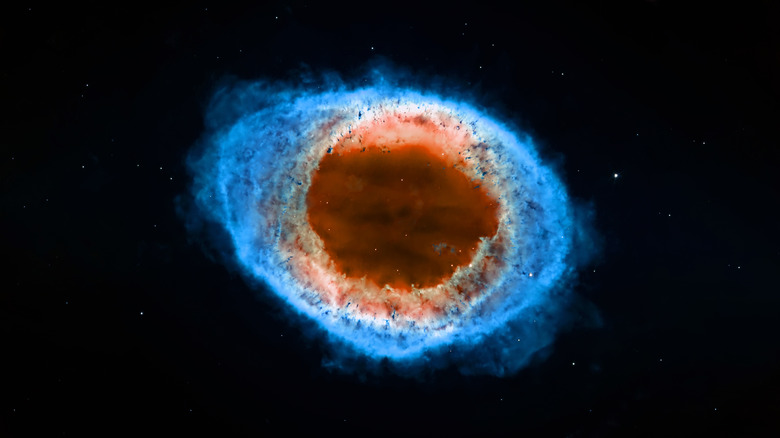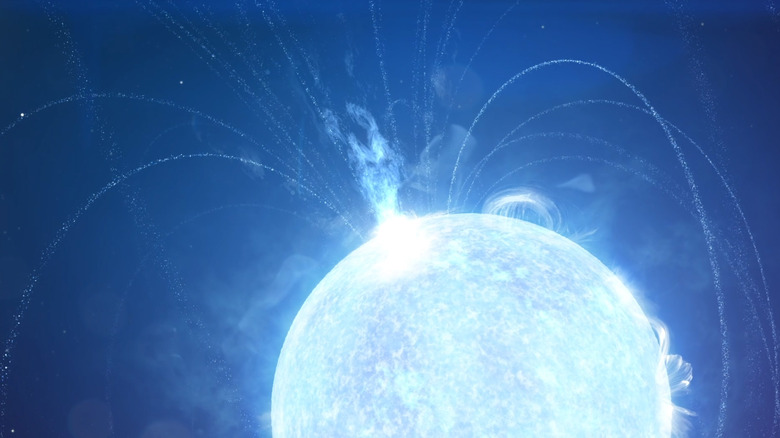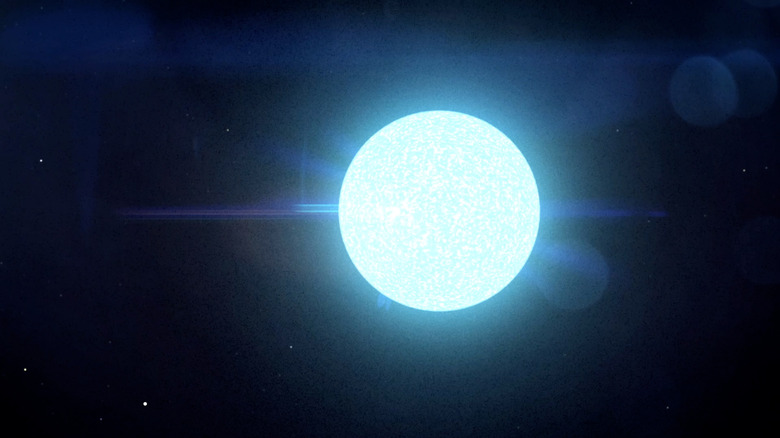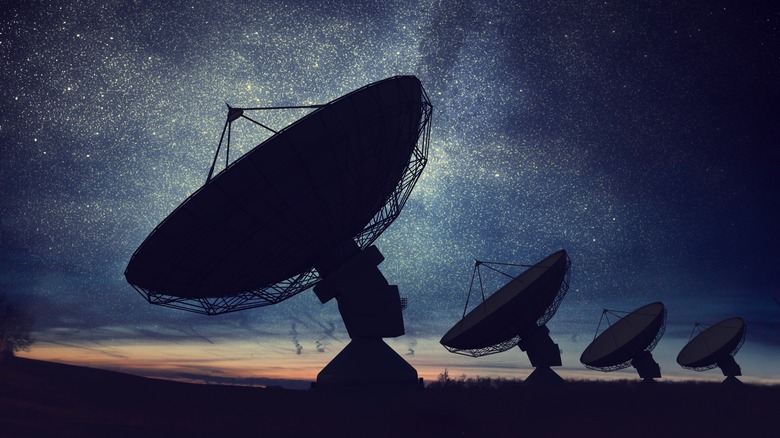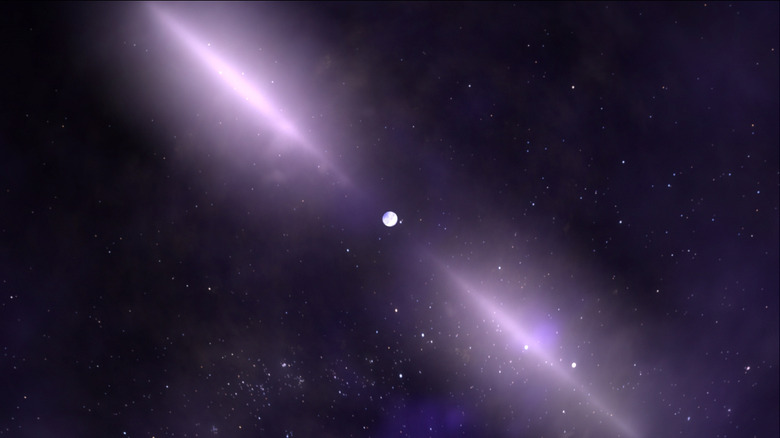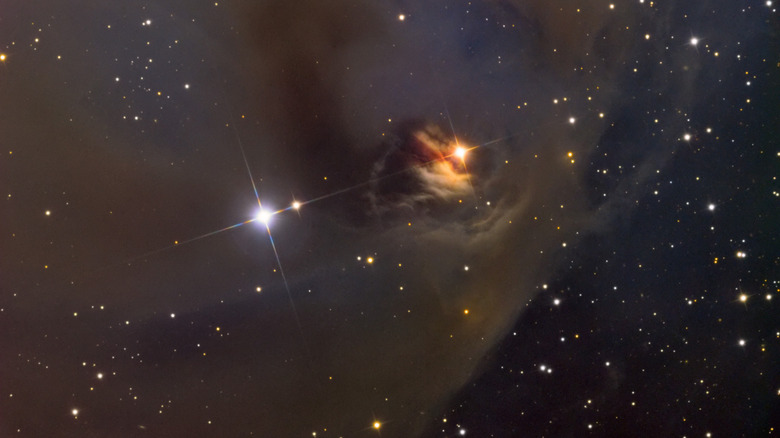Starquakes Could Be The Cause Of This Strange Cosmic Conundrum
Four and a half billion years ago, an interstellar cloud stirred, possibly when a neighboring star went supernova (via Harvard). Gravity pulled and fused its matter until the nebula collapsed in on itself. The dramatic shock ignited the core, which grew into our sun. At the same time, the gas and dust from this stellar nursery were flung far out into space. Later on, it would all clump into our solar system's planets and moons (via Cornell). The Earth was among them, but it was nothing like the life-giving blue planet we know today.
Primitive Earth was hot star matter. Over millions of years, the surface cooled into the crust beneath our feet (via UChicago). And the interior was differentiated into molten rock (mantle) and semi-solid metal core. The crust, mantle, and core make up our planet's current structure. Many branches of science contribute to uncovering this story. But surprisingly enough, studying earthquakes provides us with the most telling clues.
Shockwaves, or seismic waves, allow scientists to map the planet's interior. Since the technique is universal, they can also study other terrestrial objects in our solar system that quake — moonquakes, marsquakes, and venusquakes (via NASA).
But seismic activity isn't limited to such celestial bodies. Even stars quake and tremor. And starquakes are as violent as they get on the Richter scale. We can learn about a star's features from its starquakes. Also, they can potentially answer some unexplained mysteries that puzzle astronomers.
Puzzling blinks from the cosmos
Almost fifteen years ago, the radio telescope at the Parkes Observatory, Australia, detected a bright, intense flash in the sky (via SwinBurne). Since then, plenty of these flashes have been discovered (both in real-time and archived data). Their origins are unknown, they seemingly appear at random, and they only last for a few milliseconds.
These powerful radio wave pulses were dubbed Fast Radio Bursts or FRBs. It's a one-of-a-kind phenomenon without a clearly identified source.
Typically, it's impossible to predict where or how far away the next FRB might originate. But on rare occasions, Fast Radio Bursts repeat. So astronomers know where to point their radio telescopes to detect them. FRB 121102 is one such repeating burst that comes from outside our galaxy, almost three billion light years away (via Harvard). Over the past decade, researchers have observed hundreds of blinking radio pulses emitted from the same source. While FRBs remain a mystery, the data gathered promises some exciting leads.
Mountain in a matchbox
When a massive star (with the mass of 10 to 25 suns) runs out of fuel, the delicate balance of gravity and fusion that keeps it burning tips in gravity's favor. The star collapses under its weight and explodes in a brilliant supernova that can outshine entire galaxies in its last moments (via NASA). What's left behind is an iron core that's the densest thing in the universe — a neutron star. It's 1.5 times the size of our sun but squeezed into a radius of only a few miles. Imagine the Himalayas in a shoebox.
A neutron star is so dense that it can press atoms into neutrons, creating a neutron-rich interior. At the heart of a neutron star, matter breaks down into melded sheets of elementary particles called nuclear pasta (via Cornell). It's the toughest material in the universe — thought to be unbreakable. On the surface, you'll find a smooth, solid crust. And between the crust and core, a sea of neutrons is held together by immense forces. It all parallels the crust, mantle, and core of the Earth.
How neutron starquakes can cause Fast Radio Bursts
Curiously, neutron stars could be the source of those peculiar Fast Radio Bursts (via The Astrophysical Journal). Even though they are made of plasma and gas, shockwaves can ripple through stars, creating seismic activity. But neutron stars have a more unexpected structure in that it almost resembles the interior of our own planet.
And Fast Radio Bursts might be coming from neutron starquakes. Firstly, they only last a few milliseconds at best, suggesting their source is small — small enough to span a radius of only a few miles, about the size of a neutron star. Secondly, energy patterns collected from repeating Fast Radio Bursts are analogous to what an earthquake (and its aftershocks) would produce. And these starquakes might be sending out repeating pulses of radio waves (via Scientific American).
Researchers will need more data before they can conclusively verify this hypothesis. But neutron starquakes might be responsible for at least some, if not all, Fast Radio Bursts.
Glitching in pulsars
Stars spin on their axes and continue to do so even after they go supernova. While they're collapsing in on themselves, they start rotating faster and faster. If the conditions are right, neutron stars continue to spin at a steady rate, emitting tremendous surges of electromagnetic energy from the opposite poles. The neutron star appears to pulsate as the opposing streams of radiation pop in and out of our view. It's now a pulsar (via ATNF).
The blinking (or periodicity) of pulsars is almost perfectly steady — precise enough to be used as clocks, really (via NY Times). Researchers compare them to atomic clocks, except they'll outlast any of our technology. But there is a strange mystery associated with the highly-predictable motion of a pulsar. As the pulsar ages, it should gradually slow down as it spews out more and more radiation. Sometimes, the rotation of a pulsar speeds up, making it blink faster than usual. It can take days or years for the pulsar to go back to its original spin. No one knows exactly why or how this glitch occurs, but starquakes offer one possible explanation.
Starquakes on neutron stars ripple the evenly distributed star matter inside (via Oxford). It briefly changes the star's mass distribution further towards the center, making the pulsar rotate faster (picture a ballerina folding her arms close while spinning).
Stars that change their brightness
To accurately tell how far away the nearest stars are, astronomers use the parallax method. It involves observing a nearby star as it moves against a background of distant ones. But parallax cannot measure distances in the farther reaches of (or beyond) the Milky Way. So instead, they compare far-off celestial objects to stars of known luminosity. They're called standard candles (via SwinBurne). RR Lyrae variable stars are a cluster of standard candles featuring stars whose brightness changes with time. The class is named after RR Lyrae — the brightest variable star in the constellation.
RR Lyrae's luminosity cycles between peaks and lows steadily almost every dozen hours. Although the interval is regular, the peaks go up and down. It's dubbed the Blazhko effect. No one knows how or why it happens. But waves rippling through the star could potentially create the Blazhko effect (via NASA). Variable stars shift in brightness because fiery streams of gas surge through their interior over and over. The seismic waves don't travel at the same speed throughout, however. They can speed up or slow down as they pass through different layers of gas and plasma.
It's still debated, but researchers speculate that the rippling heat waves can resonate. It would raise the amplitude, lifting the peak farther out. Think of why soldiers don't march in lockstep on bridges. Marching in unison creates resonance, amplifying the small tremors and risking a collapse (via LiveScience).
